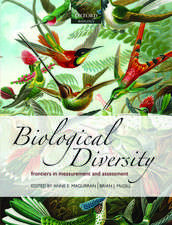Ecology of Bats
Editat de T.H. Kunzen Limba Engleză Paperback – noi 2011
Preț: 646.62 lei
Preț vechi: 760.73 lei
-15% Nou
Puncte Express: 970
Preț estimativ în valută:
123.77€ • 134.49$ • 104.03£
123.77€ • 134.49$ • 104.03£
Carte tipărită la comandă
Livrare economică 21 aprilie-05 mai
Preluare comenzi: 021 569.72.76
Specificații
ISBN-13: 9781461334231
ISBN-10: 1461334233
Pagini: 444
Ilustrații: XVIII, 450 p. 54 illus.
Dimensiuni: 152 x 229 x 23 mm
Greutate: 0.59 kg
Ediția:1982
Editura: Springer Us
Colecția Springer
Locul publicării:New York, NY, United States
ISBN-10: 1461334233
Pagini: 444
Ilustrații: XVIII, 450 p. 54 illus.
Dimensiuni: 152 x 229 x 23 mm
Greutate: 0.59 kg
Ediția:1982
Editura: Springer Us
Colecția Springer
Locul publicării:New York, NY, United States
Public țintă
ResearchCuprins
1 Roosting Ecology.- 1. Introduction.- 2. Day Roosts.- 3. Night Roosts.- 4. Summary.- 5. References.- 2 Ecology of Bat Reproduction.- 1. Introduction.- 2. The Timing of Breeding Seasons.- 3. Environmental Factors Affecting Specific Reproductive Events.- 4. Summary.- 5. References.- 3 Growth and Survival of Bats.- 1. Introduction.- 2. Prenatal Growth and Development.- 3. Postnatal Growth and Development.- 4. Survival.- 5. Summary.- 6. References.- 4 Evolutionary Alternatives in the Physiological Ecology of Bats.- 1. Introduction.- 2. The Energetics of Bats.- 3. The Water Balance of Bats.- 4. Distributional Limits to Bats.- 5. Summary.- 6. References.- 5 Ecological Aspects of Bat Activity Rhythms.- 1. Introduction.- 2. Methods for Recording the Activity of Bats.- 3. Activity Patterns and Timing of Flight Activity under Natural and Controlled Conditions.- 4. Activity Rhythms during Hibernation.- 5. The Endogenous Origin of Bat Activity Rhythms.- 6. Ecological Adaptation of Circadian Systems and Evolutionary Aspects.- 7. Summary.- 8. References.- 6 Ecological Significance of Chiropteran Morphology.- 1. Introduction.- 2. The Trophic Niche.- 3. Morphology and Community Structure.- 4. Sexual Dimorphism.- 5. Geographic Variation.- 6. Summary.- 7. References.- 7 Echolocation, Insect Hearing, and Feeding Ecology of Insectivorous Bats.- 1. Introduction.- 2. Echolocation Calls.- 3. Hearing and Insect Defense.- 4. Responses of Bats to Insect Hearing.- 5. Bats as Specialists.- 6. Other Considerations.- 7. Summary.- 8. References.- 8 Foraging Strategies of Plant-Visiting Bats.- 1. Introduction.- 2. Food Availability and General Foraging Strategies.- 3. The Foraging Behavior of Plant-Visiting Bats.- 4. Summary and General Conclusions.- 5. References.- 9 Coevolution between Bats and Plants.- 1. Introduction.- 2. Coupled Speciation.- 3. Complex Coadaptations between Bats and Plants.- 4. Ecological Consequences of Bat-Plant Interactions.- 5. Does Coevolution “Matter”?.- 6. Summary.- 7. References.- 10 Ecology of Insects Ectoparasitic on Bats.- 1. Introduction.- 2. LifeCycles.- 3. Host Associations.- 4. Host Location and Dispersal.- 5. Behavior on or Near the Host.- 6. Population Dynamics.- 7. Conclusions.- 8. Appendix.- 9. References.- Author Index.- Species Index.









